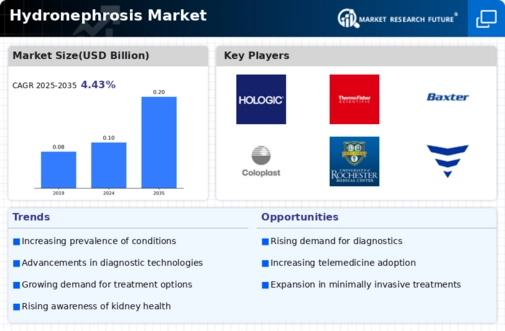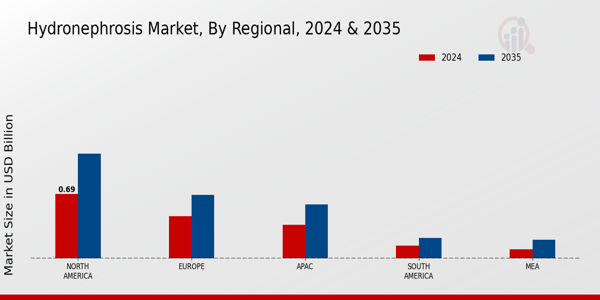Market Growth Projections
The Global Hydronephrosis Market Industry is projected to experience substantial growth over the next decade. With a market value of 0.1 USD Billion in 2024, it is anticipated to reach 0.2 USD Billion by 2035, indicating a robust expansion trajectory. The compound annual growth rate (CAGR) of 6.5% from 2025 to 2035 suggests a sustained increase in demand for hydronephrosis-related healthcare services and products. This growth may be driven by various factors, including advancements in treatment options, increased awareness, and demographic shifts. Stakeholders in the healthcare sector should closely monitor these trends to capitalize on emerging opportunities.
Growing Awareness and Education
Increased awareness and education regarding hydronephrosis and its implications are pivotal drivers of the Global Hydronephrosis Market Industry. Public health campaigns and educational initiatives by healthcare organizations are likely to inform individuals about the symptoms and risks associated with this condition. This heightened awareness may lead to earlier diagnosis and treatment, ultimately improving patient outcomes. As more individuals seek medical attention for hydronephrosis, the demand for healthcare services and interventions is expected to rise. This trend could significantly influence market dynamics, particularly as the industry adapts to meet the needs of an informed patient population.
Advancements in Diagnostic Technologies
Technological innovations in diagnostic imaging, such as ultrasound, CT scans, and MRI, are significantly influencing the Global Hydronephrosis Market Industry. These advancements facilitate early detection and accurate assessment of hydronephrosis, leading to timely interventions. As healthcare facilities adopt these technologies, the efficiency of diagnosis improves, potentially reducing the burden of advanced disease. The market is expected to benefit from these developments, as they enhance patient outcomes and drive demand for related healthcare services. This trend may contribute to the projected market growth, with an anticipated CAGR of 6.5% from 2025 to 2035.
Aging Population and Associated Health Issues
The aging population is a critical factor impacting the Global Hydronephrosis Market Industry. As individuals age, the likelihood of developing conditions that can lead to hydronephrosis, such as prostate enlargement and kidney dysfunction, increases. This demographic shift is expected to drive demand for healthcare services focused on managing hydronephrosis. By 2035, the market is projected to reach 0.2 USD Billion, reflecting the growing need for effective treatment options for older adults. Healthcare providers may need to adapt their strategies to address the unique challenges posed by this demographic, potentially leading to innovative solutions in hydronephrosis management.
Rising Incidence of Urinary Tract Obstructions
The Global Hydronephrosis Market Industry is experiencing growth due to the increasing prevalence of urinary tract obstructions, which can lead to hydronephrosis. Factors such as kidney stones, tumors, and congenital abnormalities contribute to this rise. In 2024, the market is projected to reach 0.1 USD Billion, reflecting the urgent need for effective treatment options. As awareness of these conditions grows, healthcare providers are likely to enhance diagnostic and therapeutic measures, thereby driving market expansion. This trend indicates a potential increase in healthcare expenditures related to hydronephrosis management, which may further stimulate market growth.
Increased Investment in Healthcare Infrastructure
Investment in healthcare infrastructure is a significant driver of the Global Hydronephrosis Market Industry. Governments and private entities are likely to allocate resources towards enhancing healthcare facilities, particularly in developing regions. Improved access to healthcare services can facilitate timely diagnosis and treatment of hydronephrosis, thereby addressing the rising incidence of this condition. As healthcare systems evolve, the integration of advanced technologies and treatment modalities may further enhance patient care. This trend suggests a positive outlook for the market, as increased investment is expected to correlate with improved healthcare outcomes and greater demand for hydronephrosis management.





















